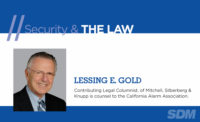A plaintiff brought a suit against the defendant insurance company to enforce their contractual rights to their insurance coverage. After the plaintiff’s liquor store burned down, the defendant refused to pay the claim. It reasoned that the coverage was excluded by the plaintiffs’ failure to maintain an automatic fire alarm. The two parties filed cross-motions for summary judgment.
The owner of the plaintiff company consulted with an insurance agent regarding this business. They met several times and decided on the insurance plan offered through the defendant. The agent asked the owner if he had an alarm. The owner said that he did and the agent asked no further questions about alarms. A contract containing a protective safeguard endorsement (PSE) was signed and mailed to the plaintiff. The owner acknowledged that he read the PSE, but stated that he did not understand it.
The PSE was headlined, in all caps, “THIS ENDORSEMENT CHANGES THE POLICY, PLEASE READ IT CAREFULLY.” The PSE had a table listing under “Protective Safeguards Symbols Applicable,” the code “P-2.” Next to that box, there was another labelled “Description of 'P-9' if Applicable.” The box beneath that read “Local Burglar Alarm Fire Alarm.” Part of this page-long contract modification defined both “Automatic Sprinkler System” and “Automatic Fire Alarm.” P-9 was defined as “the protective system described in the schedule. Sub-part B amended the contract’s provisions on exclusions.” It provided as follows:
We will not pay for loss or damages caused by or resulting from fire, if prior to the fire, you:
- Knew of any suspension or impairment of any protective safeguard listed in the schedule above, and over which you had control, in complete working order.
- Failed to maintain any protective safeguard listed in the schedule above, and over which you had control, in complete working order.
The owner had only three motion-detecting alarms in his store. Each alarm was located near a door. On August 28, 2016, all of the alarms went off, alerting to motion within the store. The alarm center placed two calls to the store to ascertain if anyone was there, and a third call to the local police department. The police department dispatched an officer to the scene, and either by the officer’s call or by some third party’s actions, the fire department was notified that there was a fire. The owner was unable to save any inventory from the store, and to date the store remains shuttered. Subsequent investigation established that the fire was an arson.
After sending an expert, the insurance company denied the owner’s claim based on the fact that he had failed to install an automatic fire alarm as required by the contract.
At issue is whether or not the plaintiffs’ motion sensor alarm system qualified as an “automatic fire alarm” under the PSE of the insurance contract.
The court’s first task was to determine whether or not the contract was ambiguous. If no reasonable person could dispute the meaning of ordinary and plain contract language, the court must accept and enforce the language as written, unless the contract is contrary to law or public policy.
By contrast, an ambiguous contract provision can raise a question of fact as to the interpretation of extrinsic evidence. An ambiguity exists where the terms of an insurance contract could suggest more than one meaning when viewed objectively by a reasonably intelligent person who has examined the context of the entire agreement and who is cognizant of the customs, practices, usages, and terminology as generally understood in the particular trade or business.
While the term automatic fire alarm in the PSE included no definition for fire alarm, fire alarm is not an ambiguous term. The term fire alarm unambiguously refers to a device meant to alert people of the presence of a fire. There is no circumventing the simple fact that the plaintiffs’ alarm was an automatic burglary alarm, not an automatic fire alarm.
Given the context of the PSE, therefore, the plaintiffs’ argument that they were not on notice that the PSE required an automatic fire alarm is unreasonable.
The PSE is clear that failure to maintain an automatic fire alarm, or knowledge of its suspension or impairment, is grounds for excluding coverage in the event of a fire.
The court concluded that there is no indication that the plaintiff complied with the conditions of the insurance contract. The owner signed an endorsement stating that he had a fire alarm, and that if that alarm system was not maintained, coverage for fire damage would be excluded. The plaintiff cannot recover damages to the insured property.
Therefore, the court denied the plaintiff’s Motion for Summary Judgment and granted the defendant insurance company’s Motion for Summary Judgment.



